How difficult is it to carry out a MaaS project?
Some might think that it is too difficult to satisfy the thirst for freedom of movement of citizens and tourists, at least in a reasonable time. This is because, until a few years ago the acronym MaaS aroused mistrust and skepticism. Now that the market is convinced of the potential and benefit of this “new digital mobility”, fear has given way to a spontaneous sense of curiosity. It is the understandable reaction that arises from facing something new, from entering a terrain that is in many cases unexplored and has many unknowns.
The desire to share the experience gained with the “MaaS Veneto” project aims precisely to tell how it was possible to walk a new path, to develop new solutions to many existing problems and, from a practical point of view, to implement one of the first Level 3 MaaS projects in Italy. Inherent and complex issues can be addressed and resolved very effectively with the right approach.
The MaaS Veneto project was commissioned by the Veneto Region which, at the end of 2020, decided to take a challenging path which today, at the official presentation of the completed project, is definitely in line with the most current trends, not only at a national but also at a European level. It was therefore an act of strategic foresight that took place ahead of its time, which led to a project whose rollout coincides precisely with the hottest months of the start of the MaaS4Italy project.
The main goal to which the Veneto Region wanted to respond to was the need for an integrated use of public transport and other mobility services in the territory. Great attention has been paid to the needs of tourists, with the primary objective of promoting sustainable mobility for this category of users who are not familiar with the local transport systems.
The average tourist is easily recognizable when moving around the city because they hold their smartphone firmly in their hand. The smartphone is their compass for orientation and the main point of information retrieval: from online hotel reservations, to finding the opening hours of a museum, through to carefully reading the reviews of a restaurant in the center. MaaS is nothing more than bringing sustainable mobility into people’s pockets, just as in other sectors it has already been extensively performed for years. The smartphone must be equipped to provide both information and access to sustainable mobility in the area, leveraging for instance the ability to make digital payments: in this way the travel experience is complete, comprehensive and autonomous. The MaaS Veneto project aims to accomplish this goal, focusing in particular on the regional route most frequented by tourists: the axis between Verona and Venice, which are the two main cities in terms of size and tourist attractiveness, known and appreciated all over the world.
The starting point was the involvement of stakeholders, who represented not only their respective roles and competences, but also the individual complexities of their organizations.
The transport operators involved were:
- AVM / Actv Venice, which is the public transport operator in Venice that provides bus transport services and manages maritime navigation with a fleet of water buses
- ATV Verona, that is the public transport operator of the city of Verona and operates urban and suburban road services
- Verona Bike, which is the bike sharing service in Verona, managed by Clear Channel
- Trenitalia, that is the national railway provider
The public entities that managed the project are:
- Veneto Region
- Venetian Infrastructures
To achieve the project objectives, we had to face the following initial assumptions:
- Absence of integrated regional ticketing. The fare integration is conventionally identified as the possibility of using the same ticket to travel on all means of transport present in a given territory; in some contexts it can also take the form of “mobility packages” or “fare bundles”. The purpose of fare integration is to make life easier for people: ease of use translates into greater attractiveness of local public transport, which is the backbone of MaaS.
- Lack of a full-digital access point for regional mobility. Many sectors have already explored the potential of accessing public or private services through a full-digital approach, namely through the smartphone we have in our pockets, without the reliance of traditional ticket selling carried out by dedicated staff at a ticket counter or office and without hardware installed on site (such as ticket machines). This approach leads to great advantages of rapid scalability and self-service usage by the ridership. The MaaS, which as a principle pursues the intermodal scalability of transport, realizes the full-digital paradigm of technology which leverages the capabilities of a mobile device as a preferential channel.
- Heterogeneity of the reference legislation. On one hand, there are no specific regulations governing the advent of integrated travel tickets and on the other, different types of transport must understandably refer to different individual regulations. It was therefore necessary to address delicate issues such as the ownership of the travel ticket, the fiscal aspects (for example the VAT rates to be applied), the specific regulations of the individual transport services and the dynamics of customer assistance service (with the clear definition of the duties to be performed and clear delineation and appointment of the responsibility in the case of a combination of multiple services).
- Very different levels of digitization across various transport services. The services available belong to different categories: scheduled public transport services, sharing solutions with booking and activation, maritime navigation with access control turnstiles. It is therefore essential to preserve the specific operational and technological dynamics provided for access to individual transport services but at the same time guarantee travelers a clear, consistent and seamless user experience.
The MaaS Veneto project consists of 3 architectural levels:
- An Account Based ticketing system that operates in parallel with the Automated Fare Collection systems of all the transport operators involved, in other words a solution that manages the entire life cycle of the ticket, from issue to validation. An Account Based ticketing system on a general basis, brings with it full multi-channeling (smart card, digital thermal ticket, mobile app, etc.) allowing both the self-service purchase of the ticket by the users as well as the sale by ticket shops. This project initially leverages only on the mobile channel and features only integrated travel tickets, for the sake of greater clarity towards the tourists; in the future it will be possible to enable other sales channels and to include the rest of the fares of all the transport operators as well. Ticket validation exploits both validation paradigms permitted by the ISO / TR 20526 standard which describes Account Based Ticketing:
a. Direct validation. The validators installed on the water bus access turnstiles read the QR Code of the digital ticket.
b. Reverse validation, leveraging on the self-validation of the travel ticket by users. - A MaaS Integration layer that effectively integrates the digitization of all forms of transport. In addition to being a data collector, this layer contains functional modules, including an intermodal route calculation engine that also includes the so-called points of interest (POI), a fare system that allows to calculate the best fare for each trip and an API layer for the exposure of data and services to the front ends. The trip planner plays an important role especially for tourists because they rely on it to move around the territory, across multiple transport services expertly sewn together. However, journey planning is an interesting aid for residents as well, who thanks to it can discover new transport possibilities: the trip planner is ultimately the modern gateway to sustainable mobility.
- A front end that allows travelers to access and act on their travel demands with clarity and certainty. In this case the “MaaS Veneto” app was made available for iOS and Android operating systems and also as a web app at veneto.openmove.com (particularly useful in the case of occasional users). The functionalities of intermodal journey planning, fare integration and integrated payment allow to effectively bring mobility into the pockets of users. In addition, the usage guide for the app is available on this page. The “MaaS Veneto” app is just the initial channel that actually allows the use of MaaS, to which many other front ends could potentially be added: the MaaS Integration layer was created to offer multi-channeling. Just as it is reasonable to expect to find the same hotel on multiple OTAs (Online Travel Agencies), a transport ticket will in the future be available for purchase on multiple platforms. The real goal of MaaS is to provide simplified and effective travel through traditionally complex means of transport.

The “MaaS Veneto” project has led to ambitious results:
- For the first time within the Veneto region, the ridership is guaranteed an effective intermodality across multiple transport services, in particular:
○ bus
○ train
○ navigation
○ bike sharing
○ People Mover, which is the terrestrial funicular of Venice - The presence of a single ticketing and payment platform guarantees considerable ease of use in everyday life: dematerialized travel tickets have been shown to break down access barriers to public transport in particular, allowing for increased revenues.
- The intermodal journey planning makes it possible to bring mobility closer to people: a reliable source of passenger information can build loyalty to the user base and increase trust in public transport, which can thus regain competitiveness with respect to the use of private cars. In the case study relating to the MaaS project in South Tyrol, we focus in particular on the importance of passenger information: visit the dedicated page to learn more.
- The flat rates available within the “MaaS Veneto” app allow, on the one hand, effective savings and, on the other, great clarity for travelers, especially tourists. Travel tickets with a duration of 24 hours are able to be attractive to existing users and at the same time draw new users by favoring the modal shift towards more sustainable mobility.
Stakeholder satisfaction emerges from the statements made at the press conference presenting the project. The Vice President of the Veneto Region Elisa De Berti states that this is the first level 3 MaaS project in Italy: the goal is to network the most popular tourist destinations in the region, enhancing public transport. The mayor of Venice Luigi Brugnaro underlines the convenience of the integrated travel ticket, which guarantees clarity to visitors and the simplicity of one-tap purchase, while the mayor of Verona Federico Sboarina emphasizes the value for tourism and sustainability, also aiming at the 2026 Milan-Cortina Olympics.
At the dawn of the new season of MaaS and the market turmoil we are experiencing, OpenMove hopes that this very visible and important project will help set an example and the tone for other such projects, by concretely demonstrating that the adoption of Mobility-as-a-service is a positive driver of change in personal mobility, favoring intermodal travel and accessibility for everyone.

